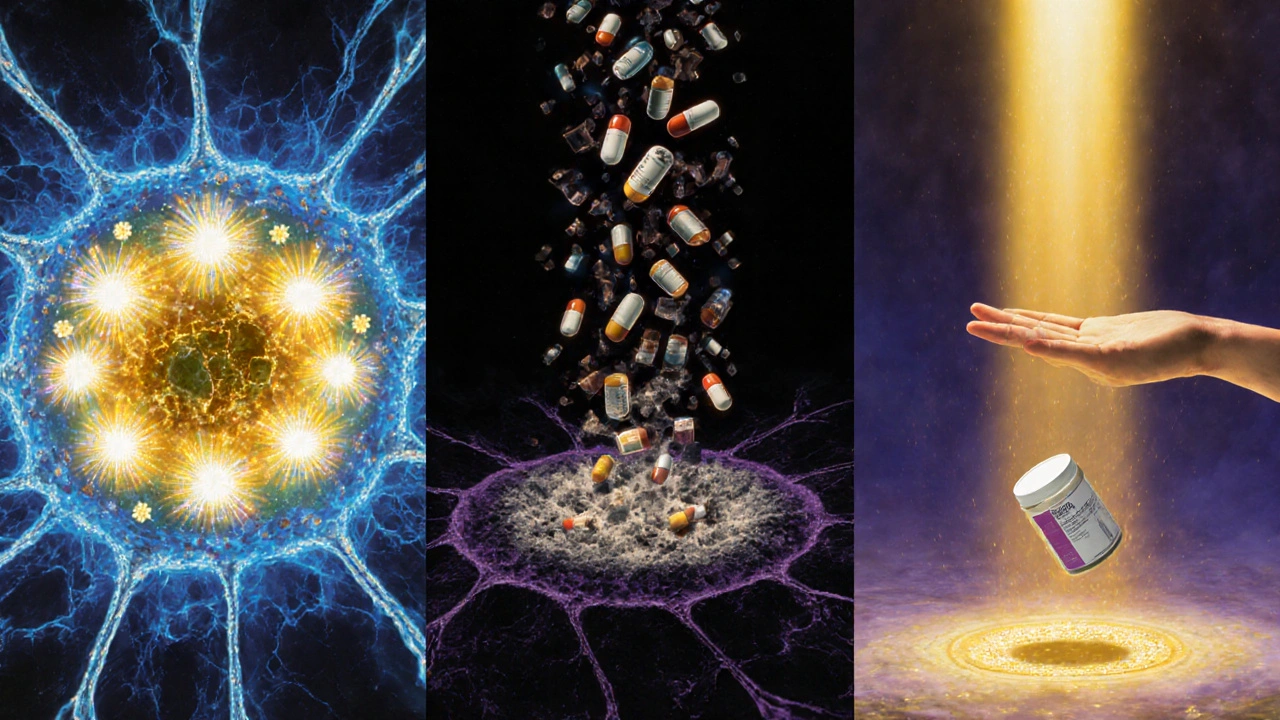Lactic Acidosis Risk Assessment Tool
Assess Your Risk of Medication-Induced Lactic Acidosis
This tool helps identify potential risk factors for lactic acidosis caused by common medications. It's not medical advice, but a general guide to help you discuss concerns with your healthcare provider.
Most people think of medications as safe when taken as prescribed. But what if the drug meant to help you could quietly push your body into a life-threatening state? Lactic acidosis is one of those silent dangers - rare, often missed, and deadly if not caught early. It doesn’t come with a warning siren. No rash. No fever. Just a slow, creeping drop in pH, rising lactate levels, and a body struggling to keep up. And it’s not just from overdoses or street drugs. It can come from common prescriptions you’re already taking.
What Exactly Is Lactic Acidosis?
Lactic acidosis happens when your blood becomes too acidic because too much lactate builds up. Normal lactate levels are between 0.5 and 2.2 mmol/L. When they hit 4 mmol/L or higher - especially with a blood pH below 7.35 - you’re in danger. Your body normally clears lactate through the liver and kidneys. But when something interferes with how your cells make energy, lactate piles up like traffic on a highway with no exits.
This isn’t the same as the burn you feel after a hard workout. That’s temporary and harmless. Medication-induced lactic acidosis is a metabolic crisis. It doesn’t need low oxygen or a heart attack to happen. It’s triggered by drugs that mess with your mitochondria - the tiny power plants inside your cells. When those fail, your body switches to inefficient, lactate-producing energy mode. And once it starts, it can spiral fast.
Which Medications Can Cause This?
It’s not just one drug. Over 50 medications have been linked to lactic acidosis. But five stand out because they’re widely used - and their risks are often overlooked.
- Metformin: The most common diabetes drug in the world. Used by over 150 million people annually. While the risk is low - about 3 to 10 cases per 100,000 patient-years - it’s still the top reported cause. The danger spikes if you have kidney problems, are dehydrated, or get sick with an infection. Even though the FDA updated guidelines in 2016 to allow use in mild kidney impairment, many doctors still don’t monitor lactate levels in high-risk patients.
- Linezolid: An antibiotic used for stubborn infections like MRSA. It’s lifesaving, but after 14 days of use, it starts blocking mitochondrial protein production. About 2.5% to 15% of patients on long courses develop lactic acidosis. The longer you’re on it, the higher the risk.
- Beta-2 agonists (like albuterol): Used for asthma and COPD. People think nebulizers are harmless. But high or frequent doses can trigger lactate levels to jump from normal to 11 mmol/L in hours. One case showed levels dropping back to 4.5 mmol/L just by cutting the nebulizer treatments from every 4 hours to every 6. Yet, many ERs and pulmonologists keep cranking up the dose when a patient’s breathing worsens - not realizing the treatment itself is causing the acidosis.
- Propofol: The sedative used in ICUs for intubated patients. When given at high doses (>4 mg/kg/h) for more than 48 hours, it can trigger propofol infusion syndrome. Lactic acidosis is a key part of this. Mortality? Over 66%. It’s rare, but when it hits, it’s often too late.
- Acetaminophen: You take it for headaches. You give it to your kids. But in elderly patients with liver issues or multiple meds, even normal doses can overload mitochondrial function. One study found diagnosis delays averaged 36 hours because doctors didn’t connect the dots.
- NRTIs (HIV drugs): Drugs like zidovudine and stavudine can damage mitochondrial DNA. Risk goes up if you’re female, have low CD4 counts, or poor kidney function.
Here’s the twist: in nearly 90% of cases, the dose was within FDA guidelines. This isn’t about abuse. It’s about hidden interactions and individual vulnerability.
Why Is This So Dangerous?
Acidosis doesn’t just make you feel bad. It cripples your heart. When blood pH drops below 7.2, your heart muscle loses 25-30% of its pumping power. Your body stops responding to adrenaline. Blood pressure crashes. Arrhythmias start. And if you’re already sick - say, with sepsis or pneumonia - this becomes a death spiral.
Doctors in the ICU face a nightmare: a patient’s lactate is rising. Is it from sepsis? From the vasopressor drip? From the albuterol nebs? From the linezolid? All of the above? That’s why it’s often missed. One review found that in 41% of cases, doctors kept giving the dangerous drug because they thought the benefit outweighed the risk. In anaphylaxis, you need epinephrine. But if lactate keeps climbing after it’s given, you need to ask: is this the drug causing it - or is it the shock?
And here’s something most don’t realize: lactic acidosis can look like worsening sepsis. The same symptoms - rapid breathing, confusion, low blood pressure - are shared. So the treatment gets intensified when what’s needed is to stop the drug.

How Is It Diagnosed and Treated?
There’s no single test. Diagnosis comes from three things: lactate level >4 mmol/L, blood pH <7.35, and bicarbonate <22 mmol/L. But experts now say: if you’re on a high-risk drug and lactate hits 3 mmol/L, don’t wait. Investigate.
First step? Stop the drug - unless it’s keeping you alive. If you’re on epinephrine for shock, you can’t just turn it off. But you can reduce the dose, switch agents, or add support.
Fluids come next. A 20-30 mL/kg IV bolus of saline helps flush out lactate and improves kidney flow. In severe metformin cases - lactate over 20 mmol/L or pH under 7.1 - hemodialysis is the gold standard. It removes both metformin and lactate in hours.
Bicarbonate? Controversial. The Surviving Sepsis guidelines say don’t use it routinely. But some doctors still give it if pH drops below 7.15. It doesn’t fix the root cause, but it can buy time.
Monitoring is key. Lactate should drop by at least 50% within two hours of stopping the drug and giving fluids. If it doesn’t, look for another cause - like sepsis or liver failure.
Who’s at Risk?
You’re not equally vulnerable. Certain people are sitting ducks:
- People over 65
- Those with kidney disease (eGFR under 60)
- Patients with liver cirrhosis
- Anyone with heart failure or sepsis
- Women on NRTIs
- Those on multiple high-risk drugs at once
One study found 72% of metformin-related lactic acidosis cases happened in people with eGFR under 60. Yet, many still get prescriptions without checking kidney function. The FDA says metformin is safe in mild impairment - but only if you monitor. Too often, that step gets skipped.

What’s Changing Now?
There’s new hope. In 2023, the FDA approved the Lactate Scout+, a handheld device that gives real-time lactate readings. In pilot studies, it cut detection time from over 12 hours to just 2.1. Hospitals in Australia and the U.S. are starting to use it on patients getting continuous epinephrine or high-dose albuterol.
The 2024 International Critical Care Guidelines now say: “Routine lactate monitoring is recommended for patients on prolonged beta-agonist therapy or high-dose vasopressors.” That’s huge. It’s no longer optional.
Researchers are also looking at genetics. A 2023 study found a variant in the POLG gene makes people 8 times more likely to get lactic acidosis from HIV drugs. Soon, we may screen for this before starting treatment.
And for linezolid? Trials are testing mitochondrial protectants - drugs that shield your cells while you’re on antibiotics. Early results are promising.
What Should You Do?
If you’re on any of these drugs, don’t panic. But do pay attention.
- If you’re on metformin and get sick with vomiting, diarrhea, or fever - call your doctor. Don’t wait. Dehydration + infection = perfect storm.
- If you’re on linezolid for more than 10 days, ask your doctor about checking lactate levels.
- If you’re on albuterol nebulizers and start feeling worse - dizzy, breathless, confused - don’t just take more. Call for help. Your breathing might be worsening because your blood is becoming acidic.
- If you’re elderly and take acetaminophen regularly, get your liver and kidney function checked every 6 months.
And if you’re a caregiver? Learn the signs: rapid breathing, confusion, extreme fatigue, nausea without stomach pain. These aren’t just “getting worse.” They could be your body screaming for help.
Final Thought: It’s Preventable
Lactic acidosis from medications isn’t common. But it’s not random. It’s predictable. We know who’s at risk. We know which drugs do it. We know how to catch it early. What’s missing is vigilance.
Doctors are busy. Patients don’t always speak up. But when lactate rises, it’s a red flag - not a footnote. The next time someone’s lactate climbs and no one knows why, ask: “What meds are they on?” That one question could save a life.

